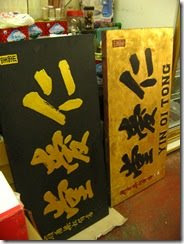


Artilce in thestar.com.my
Friday June 19, 2009
By WINNIE YEOH
By WINNIE YEOH
A TRADITIONAL Chinese medical hall that has been operating for 214 years in Penang is moving out from its current premises on China Street in George Town.
This move has prompted calls for investors or traditional medicine practitioners to step in by setting up a traditional medical hall-cum-museum to preserve the ‘living heritage’ of the building.
Sunset trade: The moving out of a two-century-old Chinese Medical hall from George Town due to dwindling profits has prompted calls to preserve its premises as a museum on the trade.
Penang exco member Chow Kon Yeow said the outlet, Yin Oi Tong, was set up by Chinese immigrants who came to Malaya.
“They were the pioneers who manufactured, processed and distributed Chinese herbs and medicines in this region to Singapore, southern Thailand, Medan and Sumatera.
“Unfortunately the tenant finds it difficult to sustain its business and they have decided to move out of the building which is owned by the Cheah Kongsi by June 30,” he said during a discussion group on Tuesday.
He said it would be a big loss if the medicine hall were to move out of the building.
Relocation of old Chinese medical hall prompts call to turn premises into museum.
Yin Oi Tong, he said, has occupied three the shoplots, each three storeys high, at 82A-C, China Street for the last 124 years.
“It’s a waste that a living heritage has to become history and a memory,” he said.
Several non-governmental organisations such as the Cultural Heritage Advisory Team (CHAT), Penang Heritage Trust and heritage researcher Tan Yeow Wooi have now joined hands to try to preserve the building’s traditional usage as a medical hall.
Tan, who earlier gave a briefing on the history of Yin Oi Tong, is proposing that the building owner, tenant, state government and the private sector join forces to rehabilitate, refurbish and preserve the Early Straits Eclectic Style building as well as the conventional trade.
“The ground floor of the building can be maintained as a traditional medical hall but the second and third floor can be transformed into a museum or gallery to showcase the artifacts of the trade,” he suggested.
He cited an example of the Tak Seng On or The Virtue and Success Pawnshop in Macau which was set up in 1917 but was left vacant in 1993.
“The Macau government invested about RM4mil to refurbish the building in 2001. It was turned into a museum and won the Honourable Mention Prize in the 2004 UNESCO Asia-Pacific Heritage Awards,” he added.
CHAT educationalist Janet Pillai said there were parties who would like to see the building turned into a multicultural medical centre.
“Traditional medicine has a strong history in Penang and if Chinese medicine can’t sustain, we can invite practitioners of other alternative medicine like Ayurvedic and Malay traditional medicine to come in.
Yin Oi Tong managing director Chong Yit Leong said the company was willing to cooperate by staying on as the core tenant and help transform part of the buildings into a museum.
“We have harboured thoughts of moving out of the premises 15 years ago but we have tourists visiting the building from time to time. That is why we continued to hang on even though we could no longer make any profits.
“We’re willing to donate our artifacts to the museum,” he said, adding that they planned to relocate to their existing smaller outlet in Paya Terubong.
Cheah Kongsi secretary Cheah Swee Huat said its tenant had submitted a contract termination letter dated March 25.
“We have received enquiries from the public on the premises but so far, we have not decided on anything.
“A Chinese daily has reported inaccurately that we hiked the rental and forced the tenant to move out. The company is moving out solely for economic reasons.
“I’ll forward the views and proposals from the discussions to the board of trustees and we’ll see what happens next,” he said.

